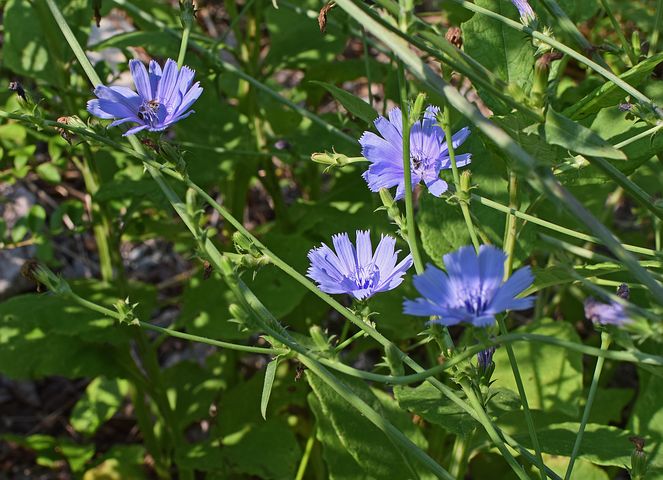When weeds are your friend
Weeds tell you lots about your soil. Before pulling them try reading what they have to say. (Nimbus takes weed duty seriously.) Image source: Michael Winters Photography
I really hate weeding. There are days it requires all the strength I have to get out there and pull these tough tufts of green from between my rows of carefully tended beans and peas. But there are reasons to like weeds, or at least respect them.
First, weeds are good for your soil. They're resilient enough to grow pretty much everywhere, no matter how poor or barren the earth. They cover and give soil life, much like a living mulch. And seasonal cycles of weeds growing and dying build up nutrients in the soil and make way for larger plants, like shrubs and trees. Without weeds, the natural landscape we love would be very different.
Weeds also tell you a lot about your soil. Before pulling your weeds try reading what they have to say about your planting area. Weeds can signal whether you have soil that’s low in nutrients, high in acid, or even waterlogged. I highly recommend buying a field guide to weeds growing in your region so you can learn from them.
Soggy soil
Weeds that signal soggy soil: Dock, horsetails, chickweed, sedge and willows.
What to do about it: Wet and soggy soils are hard to drain and frankly not worth messing with. Besides, given that wetlands are disappearing at an alarming rate it’s probably better for the planet if you just let it be.
Sedge.
Horsetail.
Compacted soil
Weeds that signal compacted soil: Chicory, knotweed, dandelion or bindweed.
Chicory.
What to do about it: Packed soil limits the ability of plants to extend their roots and absorb vital nutrients for growth. A good way to break up the soil is to plant it with a cover crop like clover or vetch in the fall. The roots can punch through the soil, loosening it in time for the next season’s crop. Another option is to use a broadfork, which is a large heavy four- pronged steel fork that loosens the soil without having to till it.
Acidic soil
Weeds that signal acidic soil: Plantain, sorrel, and stinging nettle.
Plantain.
What to do about it: Soil that is acidic has a very low pH and, unless you are growing blueberries, you don't want your soil to be acidic because your plants will struggle to survive. You can change your soil pH by adding lime, follow instructions from the supplier. The lower your pH the more lime you will need. If you don’t want to add lime, you can plant blueberries, rhubarb, endive, shallots, potatoes or watermelon in that area because they can tolerate soils as low as 5.0 pH.
Basic soil
Weeds that signal basic soil: Queen Anne’s lace, chicory, peppergrass and chickweed.
What to do about it: Basic soil is alkaline, which is another way of saying it has a very high pH. A high pH is usually a result of calcium rich bedrock. Treating basic soils with elemental sulfur quickly lowers the pH, but I prefer adding lots of compost instead because it yields a bigger return. Compost acts to buffer the soil and prevent sudden changes in pH. The complex molecular structure of compost provides a great deal of hydrogen atoms, lowering pH and enhancing soil’s ability to hold onto nutrients. Another option is to plant your basic soil with asparagus or members of the cucumber family, which do just fine in a high pH environment.
Chickweed.
Queen Anne's Lace.
Fertile soil
Weeds that signal fertile soil: Foxtail, chicory, purslane and lambsquarters.
What to do about it: Every gardener dreams about having fertile soil but the downside is that weeds love it to. This means you have to be highly vigilant about removing weeds as soon they crop up, and before they start to seed, or they’ll wreak havoc on the rest of your plants.
Dry and sandy soil
Weeds that signal dry and sandy soil: Sorrel, thistle, yarrow and nettle.
What to do about it: Sandy soil is not a terrible thing. In fact many vegetables love the loose, well-drained stuff. Best way to deal with this is to grow plants that love living in it, which include carrots, beets, onion and garlic. Toss in some extra compost for a nutrient-boost.
Yarrow.
Thistle.
Heavy clay soil
Weeds that signal heavy clay soil: Plantain, nettle and quack grass.
Nettle.
What to do about it: Most plants have a difficult time thriving in heavy clay because the dense soil makes it difficult for healthy roots to develop. But some plants do just fine in this dense environment, including shallow-rooted annuals, like lettuce, chard, and beans, which appreciate the moisture. And deep-rooted, top-heavy crops, like broccoli and cabbage, which benefit from the stability offered by clay.
Acadia Tucker takes a break with Nimbus, who gets free rein of the farm. Image source: Micheal Winters Photography
Acadia Tucker is a regenerative farmer, climate activist, and author. She has just published Growing Perennial Foods: A field guide to raising resilient herbs, fruits & vegetables. She is also the author of Growing Good Food: A citizen’s guide to backyard carbon farming.
This is part of our series on radical gardening, or how to grow food to help the planet. To find out more about growing your own perennials. Check out our Perennial Profiles.













